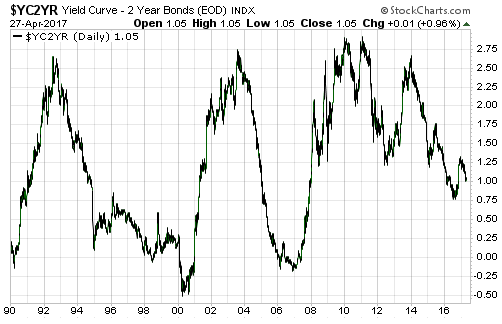The short answer to the above question is that they are neither. Read on for the longer answer.
Consider what happened to nominal interest rates during the long-term gold bull markets of the past 100 years. Interest rates generally trended downward during the gold bull market of the 1930s, upward during the gold bull market of the 1960s and 1970s, and downward during the bull market of 2001-2011. History’s message, therefore, is that the trend in the nominal interest rate does not strongly influence gold’s long-term price trend.
History tells us that gold bull markets can unfold in parallel with rising or falling nominal interest rates, but this shouldn’t be interpreted as meaning that interest rates don’t affect whether gold is in a bullish or bearish trend. The long-term trend in the nominal interest rate is not critical; what is of great importance, as far as the gold market is concerned, is the REAL interest rate, with low/falling real interest rates being bullish for gold and high/rising real interest rates being bearish. For example, when gold was making huge gains during the 1970s in parallel with high/rising nominal interest rates, real interest rates were generally low. This is because gains in inflation expectations were matching, or exceeding, gains in nominal interest rates (the real interest rate is the nominal interest rate minus the EXPECTED rate of currency depreciation).
Very low real interest rates are artifacts of central banks, because in an intervention-free market all lenders would insist on a significant real return in exchange for temporarily relinquishing control of their money. In other words, “very low real interest rates” essentially means “very loose monetary policy”.
Something else that affects gold’s price trend is the difference between long-term and short-term interest rates (the yield-spread, or yield curve), with a rising yield-spread (‘steepening’ yield curve) being bullish for gold and a falling yield-spread (flattening yield curve) being bearish. It works this way because a rising trend in long-term interest rates relative to short-term interest rates generally indicates either falling market liquidity (associated with increasing risk aversion and a flight to safety) or rising inflation expectations, both of which are bullish for gold.
As is the case with the real interest rate, under the current monetary system the yield-spread tends to be a symptom of what central banks are doing. If money were free of central bank manipulation then the yield-spread would spend most of its time near zero (the yield curve would be almost horizontal) and would experience only minor fluctuations, but thanks to the attempts by central banks to ‘stabilise’ the financial world the yield-spread experiences the huge swings shown on the chart included below.
Last but not least, gold is influenced by the economy-wide trend in credit spreads (the differences between interest rates on high-quality and low-quality debt securities). Gold, a traditional haven in times of trouble, tends to do relatively well when credit spreads are widening and relatively poorly when credit spreads are contracting.
In summary, gold benefits from low real interest rates, an increasing yield-spread (a steepening yield curve), and widening credit spreads, each of which can occur when nominal interest rates are rising or falling.
 Print This Post
Print This Post

